By Rick VanSickle
A glass of wine never tasted as good as the Dam Chardonnay I enjoyed after picking about a million grapes the other day in Niagara.
Note, also in this Ontario Wine Report: There are rules to follow if you pay an influencer for wine content (and those who get paid), ch-ch-changes at the top in the Ontario wine industry, and two top Hidden Bench wines and one “cru” Bachelder Wine part of the online Cellar release at Vintages.
OK, maybe it wasn’t a million, but it felt like a lot as I joined about a dozen other crazy people (family, friends and fans, I mean) gathered in Erv and Esther Willms’ Niagara-on-the-Lake spectacular vineyard to help the 80x Wine Company with their Chardonnay pick.
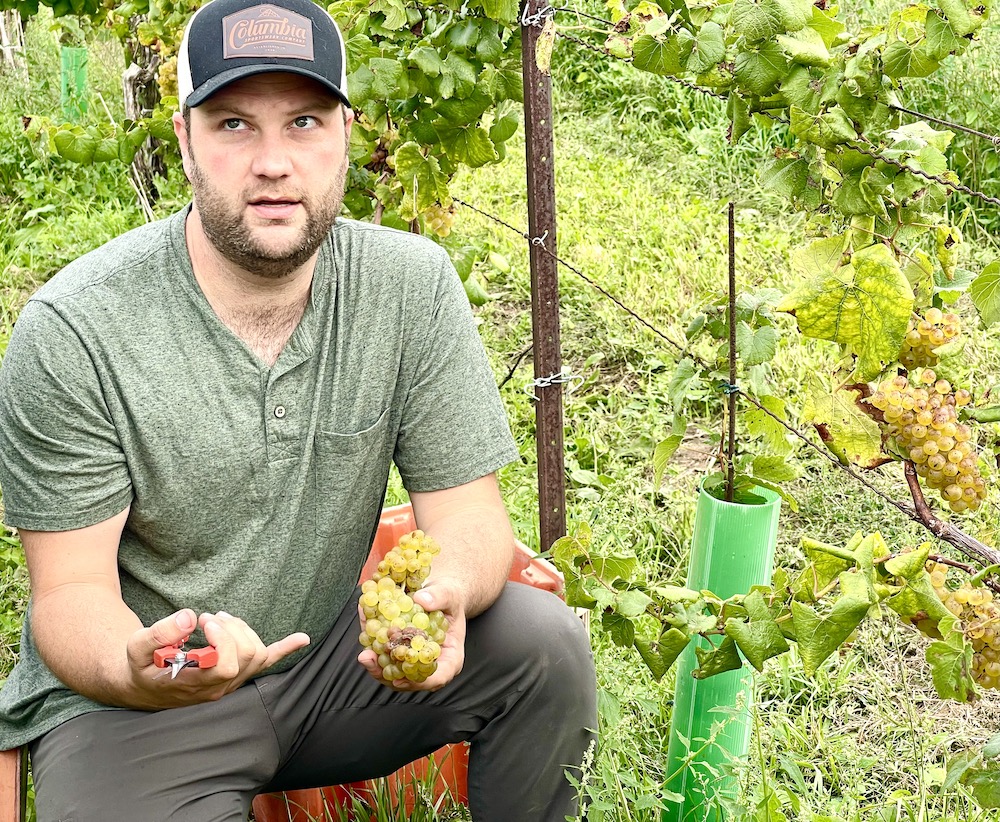
Now I completely understand why André Proulx and Guillaume Frénéhard, Adam Kern, and Vadim Chelekhov (who was busy with his own harvest at Palatine Hills), the partners behind the small, virtual wine label, call their wine Dam Chardonnay — it’s DAM hard getting it to bottle. I am exaggerating, of course. The hard truth is, hand picking grapes is quite cathartic once you get into the rhythm of it. And there is an art to the pace when clipping each bunch and flicking to the ground any unwanted grapes you encounter. As 80x winemaker and chief boss man for this pick, Kern (photo above), said before we took our positions in the vineyard: “If you spend more than 30 seconds a bunch, you’re going too slow.”
This is the sixth vintage for 80x, which generally focuses on Chardonnay, Rosé and Pinot Noir. You can buy the wines here.
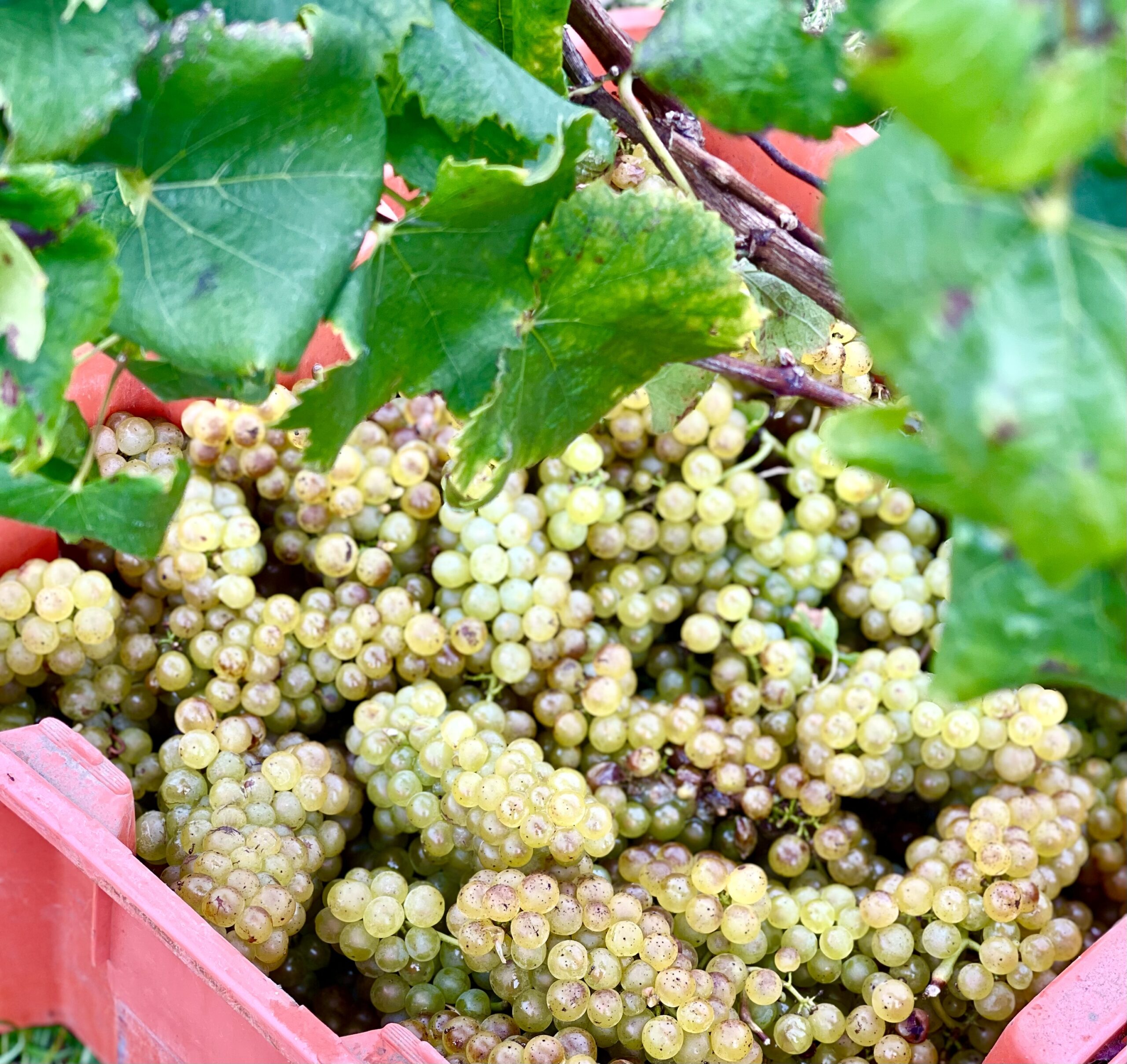
Surprisingly, after so many years covering the wine industry, this was my first time actually picking grapes. I’ve ridden shotgun on a harvester, loaded baskets of grapes on tractors, fake picked icewine grapes, and enjoyed many a harvest lunch, but had never picked grapes for real. Sadly, I only lasted until lunch time where I consumed a delicious array of 80x and Kern wines and pizza before I had to bow out with a sore back and a numb thumb caused by my old rickety clippers. But I did try to document the picking in these photos before I passed out from pain …

• A volunteer grape picker carries two buckets of freshly picked Chardonnay grapes to toss into the bin.
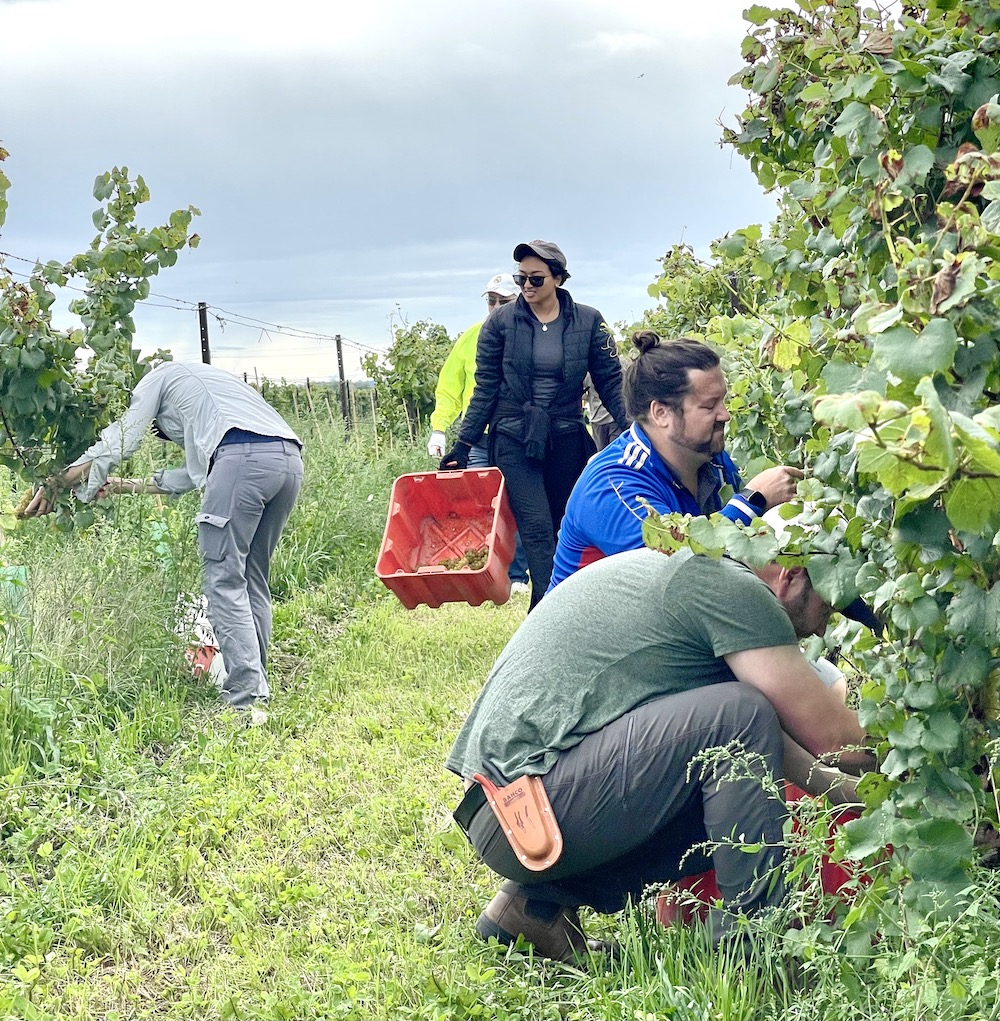
• 80x winemaker Adam Kern (foreground), André Proulx (beside him) and other volunteers get after the 80x Chardonnay grapes.
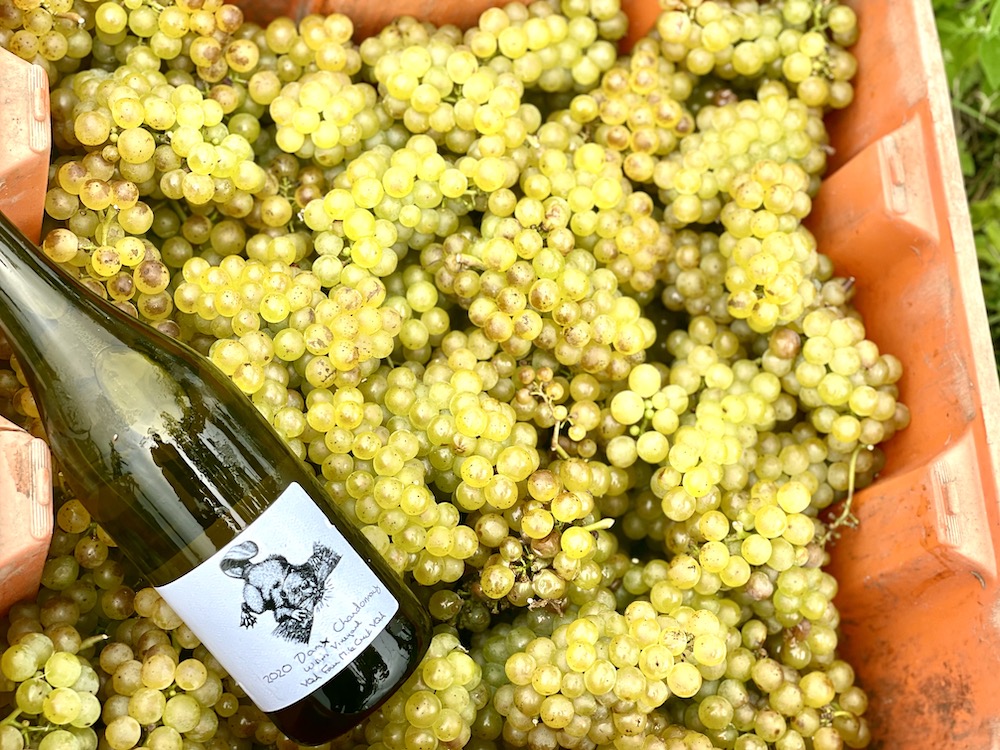
• A lunch bottle of Dam Chardonnay from 2020 photographed in a bin of 2024 Chardonnay grapes (short view)
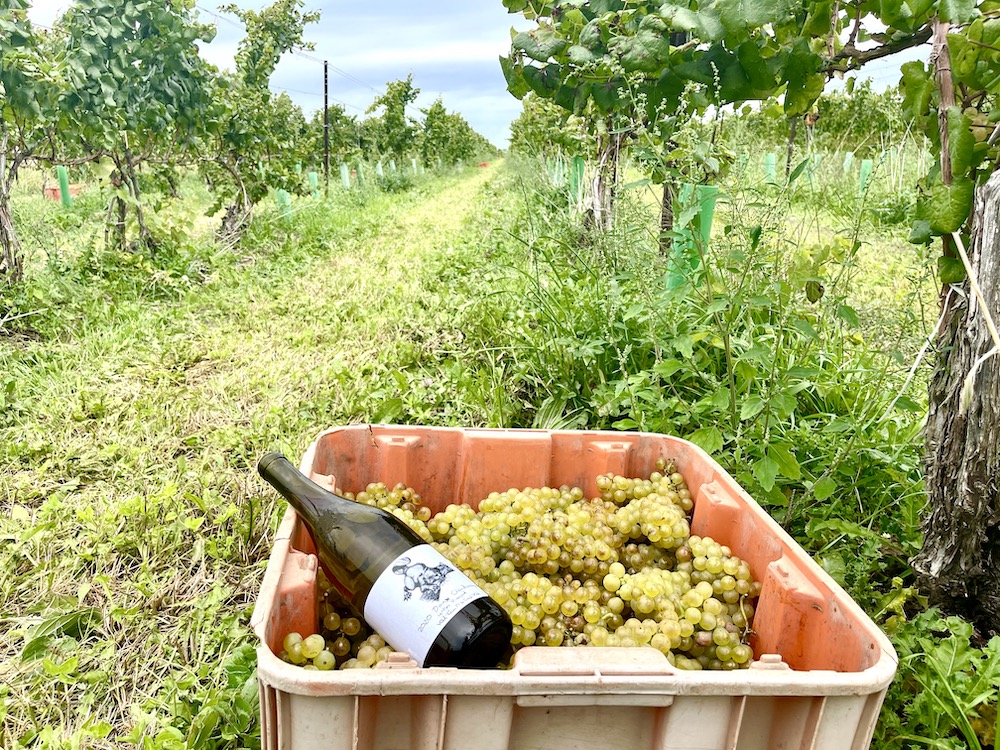
• Same thing as above, but a long view.
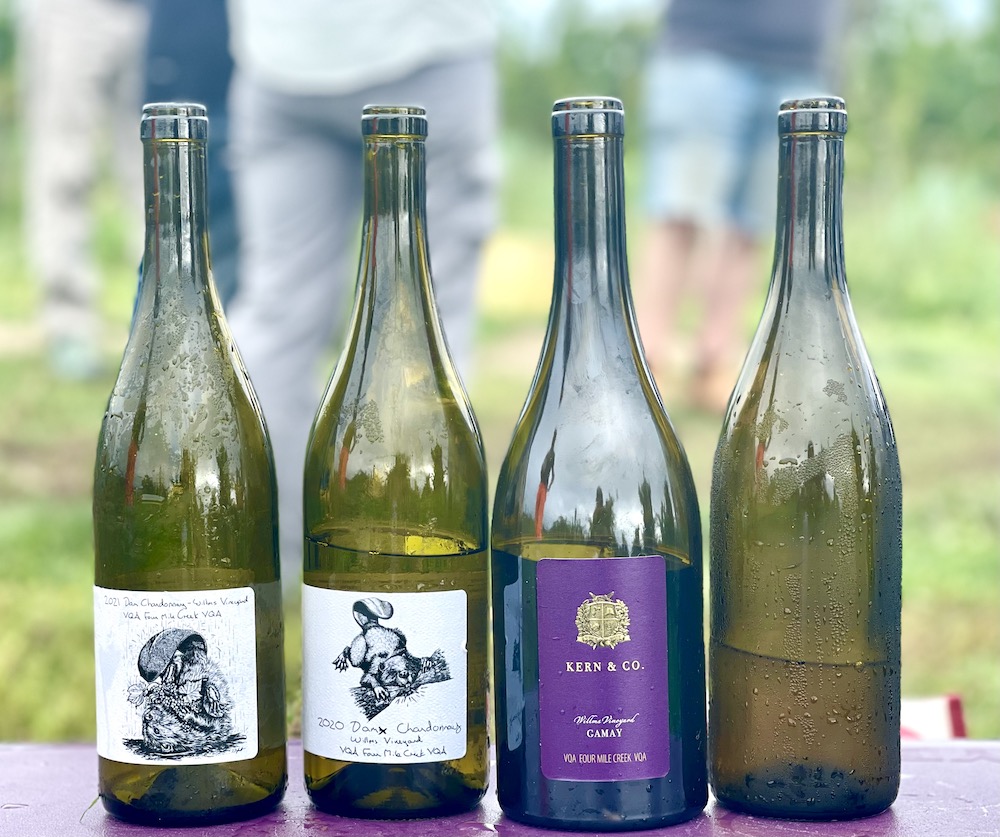
• Lunch wines from 80x and Kern and Co.
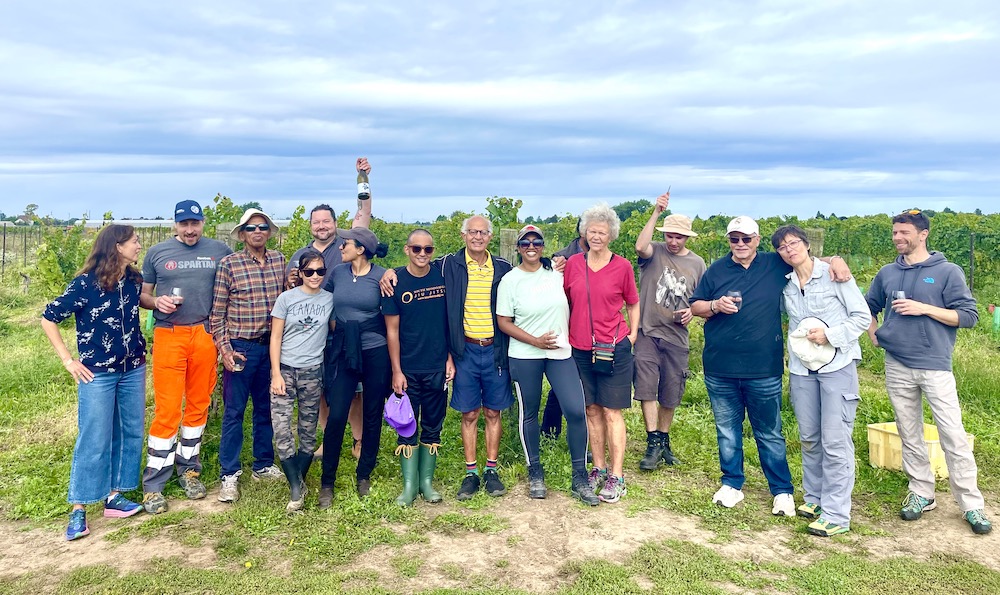
• The whole gang of pickers after a big feast of pizza and wine. Most of the names of the pickers include (please excuse us if we missed a few people): Krissy Sumnauth, David Sumnauth, Leah Sumnauth (Krissy’s sister with her kids Rohan and Mayuri), Romuald Faure, Stephane Ferber, intern Soorya Pratap Singh Manohar (Soorya), Al and Anna Lopez, and, of course, Kern, Proulx and Frénéhard.
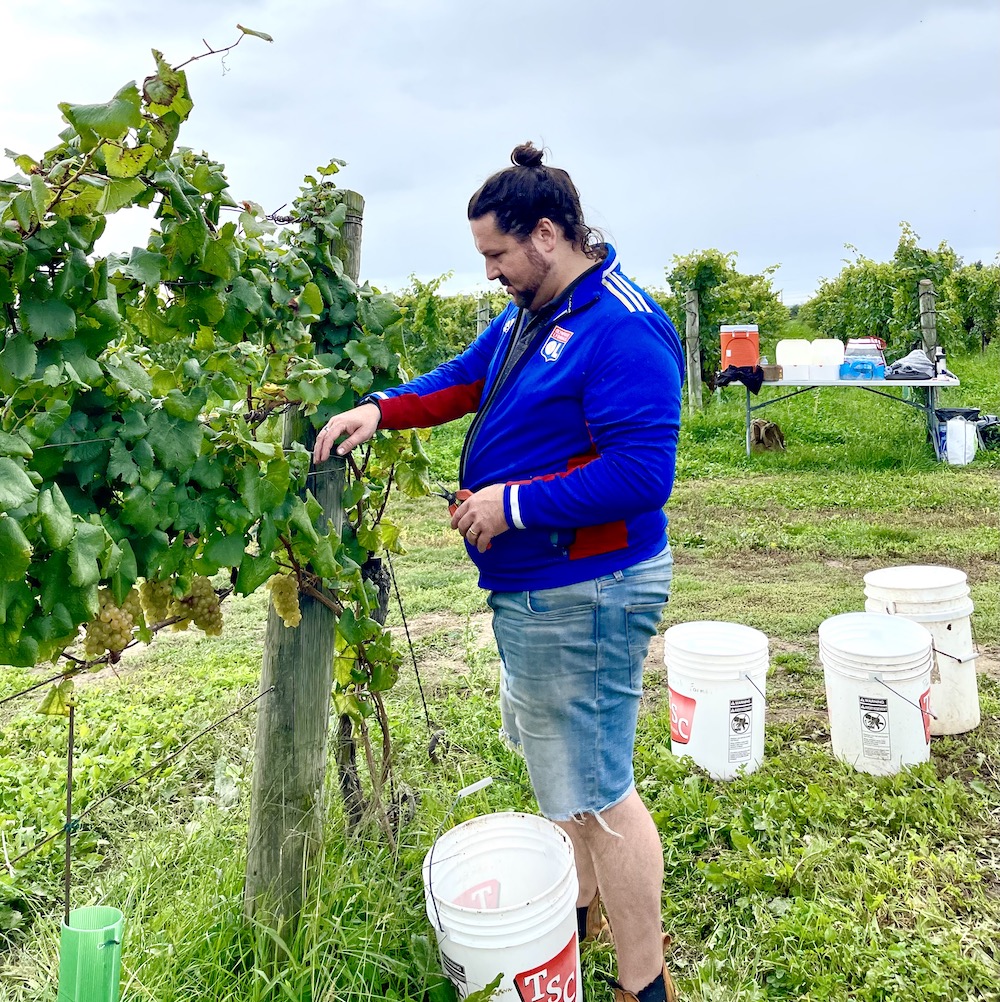
Postscript: Proulx said later that the fruit quality “was very good and very clean — we processed the fruit the following morning at Cloudsley — and there was very little left to remove on a hand sort, using the sorting table. I am looking forward to seeing what’s going to come from this vintage … I remain convinced that for our little company, that we are hoping to grow, will continue to do so with the earlier ripening varieties. Everyone in the industry seems to complain about Pinot Noir — until they taste it — so I’m excited to say that we’re working on bringing Ruff Pinot Noir back to the market. So, I guess being more succinct, I’m glad we work with Chardonnay because it’s going to be a good year for it.”
There are rules for those who
trade cash for wine content
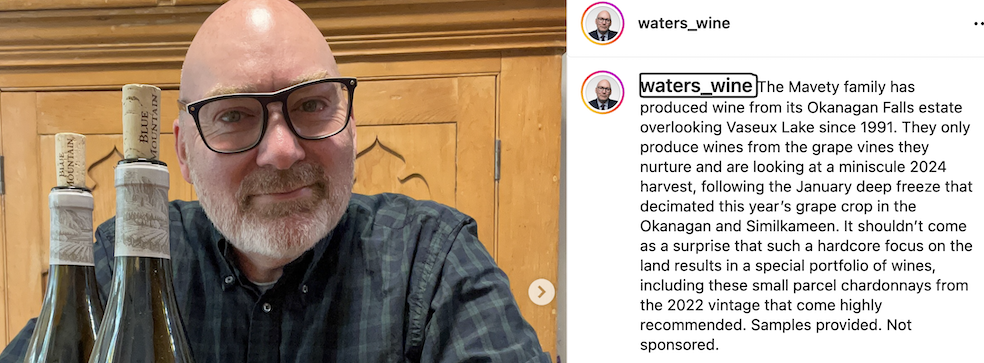
There is something quite shocking contained in the screen grab above. Can you spot it?
It’s not the photo, that’s Chris Waters, the respected veteran wine writer for the Toronto-based Globe and Mail newspaper. It’s in the caption beside his photo, this part: “Samples provided. Not sponsored.”
To me, it’s simply maddening that Waters feels compelled to point out what should be perfectly obvious. It’s absolutely bonkers that a traditional writer freelancing to the Globe and Mail, a newspaper with the highest journalistic ethics in the country, feels he has to tell people he’s not being paid to say nice things (or anything at all) about the wines he chooses to write about.
The default should always go to the journalist, not the influencer, content provider or whatever the identifier is for someone who takes money for wine reviews or wine content. It is not only their obligation to disclose whether their content is sponsored or otherwise paid for, but also part of the federal government’s Competition Act. In other words, it’s the law in Canada that you disclose if you were paid to promote someone’s products.

For Waters and other traditional wine (beer, cider, whatever) writers out there, there is absolutely no need to declare that your post IS NOT sponsored or YOU WEREN’T paid to write a glowing review, because it goes without saying. But all the others out there? They need to come clean every single time, without question and no matter if the person paying you doesn’t want you to disclose it. It’s not up to them, it’s up to you, it’s your reputation at stake. You are the boss of you.
I know traditional writers are having a difficult time trying to separate themselves from Instagram content providers who aggressively chase clients, many in the wine world, for an exchange of cash for nice comments and, yes, even glowing reviews. It’s still extremely difficult to find disclosures from those who deal in this type of content, but …
Writers such as Waters, who I know as a seasoned wine writer, should not give into offering anti-disclosures just because those who should be giving them, aren’t. Waters abides by the journalist ethics of the Globe and Mail (and beyond) and should be commended for that. It’s the last newspaper in Toronto that seems to even have an ethics policy that extends to freelancers.
Canadian rules and regulations lag behind those of the U.S. where they are adhered to more fervently by the influencer community and held accountable if they are not. Our laws don’t seem to have the backbone to provide any recourse for those who consistently do not disclose if they were paid to play.
I offer this refresher on the rules for content providers and those who hire them, because both sides should be disclosing this information whether you’re paid for it or are the recipient of it.
Influencer marketing and the Competition Act
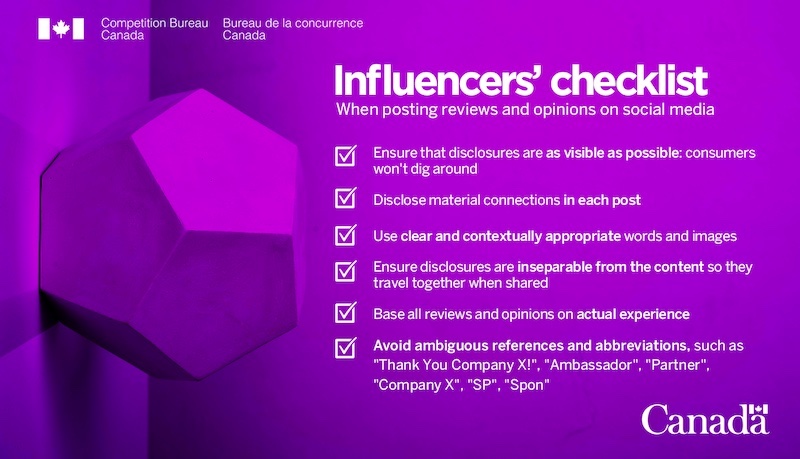
Truth in advertising is important. As an influencer, consumers rely on the opinions you share online about products and services, and believe they are genuine and impartial. It’s misleading if you don’t make it clear that your online content is actually an advertisement.
The deceptive marketing practices provisions of the Competition Act apply to anyone who is promoting a product, service, or any business interest. So, as an influencer, the Act applies to you.
You should disclose all material connections you have with the business, product or service you are promoting.
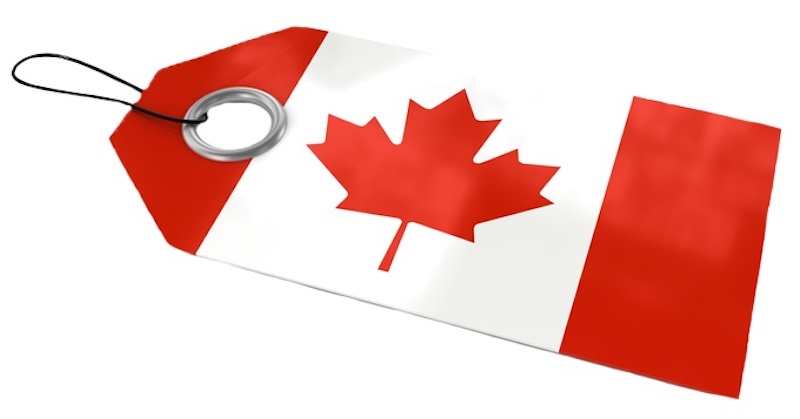
Your connections may be “material” if they have the potential to affect how consumers evaluate your independence from a brand. For example, you may have a material connection if you have:
• Received payment in money or commissions
• Received free products or services;
• Received discounts;
• Received free trips or tickets to events;
• A personal or family relationship;
Here are some best practices you should follow when disclosing these connections:
Make sure that your disclosures are as visible as possible;
Your disclosures should be prominent. Your audience may not see them if they are in a long caption, group of hashtags, or a profile bio;
Your disclosures should be visible on all devices without having to click or tap a button to expand the post;
If you share your content on multiple social media platforms, make sure your disclosures are on each one;
Make sure your disclosures are clear and contextually appropriate;
Use plain and clear language in your disclosures. Avoid ambiguous terms and abbreviations;
Keep in mind the way your audience views or experiences the content you create on social media. Certain content may require both audio and visual disclosures;
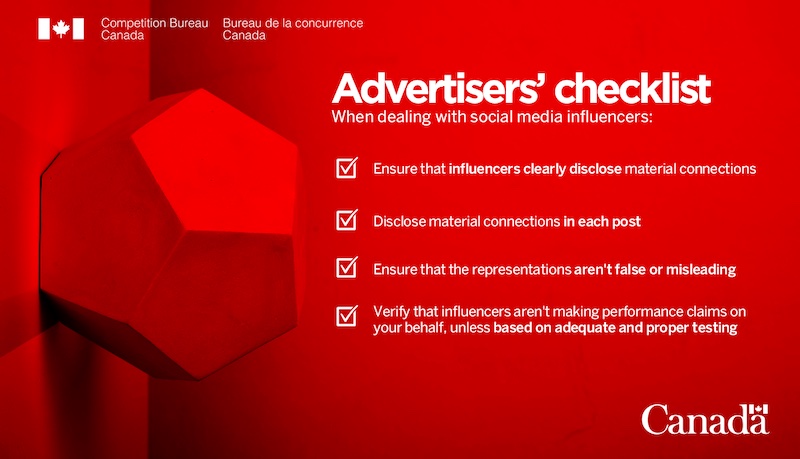
Linking to or tagging a brand, posting a discount code, or linking to an affiliate webpage is unlikely to be enough.
Ask yourself:
• Will it be clear to my audience that I have a material connection with the company that sells this product or service?;
• You should also base any reviews and testimonials on actual experience;
• Be honest about what the product has done for you;
• Don’t make broad claims about a product’s performance. Testing or proof may not exist to back up such claims, so it’s important that you stick to your own personal experience when reviewing a product.
Wine country industry ch-ch-ch-changes

Wine Country Ontario announced that Michelle Wasylyshen, above, is joining the industry association as president and CEO, starting Oct. 7.
Wasylyshen has over 25 years of experience in both the public and private sectors, according to WCO. “She is a strategic leader who understands government decision-making and stakeholder relations. In addition, her specialties include all realms of public affairs, including strategic and crisis communications, media relations, policy development and issues management,” a news release said.
Wasylyshen most recently led the media and communications functions across Canada for the Retail Council of Canada, whose membership includes over 54,000 storefronts including grocery, specialty, discount, independent retailers, online merchants, and quick service restaurants. Prior to that, she was a senior advisor in the Ontario government where she oversaw a vast array of priority files, all focused on intense stakeholder engagement. She has also managed a full range of public affairs activities for Canada’s largest energy distribution company.
Richard Linley, the outgoing president and CEO, will work closely with Wasylyshen throughout the month of October to ensure a smooth transition.
The change at the top at WCO comes five months after major changes at the Wine Marketing Association of Ontario (WMAO).

Dean Foerter, above, was named as WMAO’s full-time permanent executive director, bringing his nearly 25 years of experience in brand building, advertising, marketing, market research and new product development, with significant expertise in the wine category.
“We are delighted to welcome Dean as our permanent executive director,” said the WMAO board of directors in a joint statement. “His leadership, vision and dedication over the past several months, alongside our exceptional staff, have earned him the respect of the board, the VQA marketing committee and industry stakeholders. With Dean at the helm, we are confident in our ability to further enhance our brand strategy and marketing assets.”
Foerter replaced outgoing Sylvia Augaitis while Andrea Peters replaced Magdalena Kaiser as public relations manager, wine marketing.
Top Niagara wines shine in LCBO’s
Ontario Cellar selections online
Two Niagara superstars have wines coming out Oct. 3 in the monthly Cellar Selections at the LCBO. Ordering begins at 8:30 a.m. on Oct. 3 (today) for the online only release. Go here to order. Here are our recommendations:
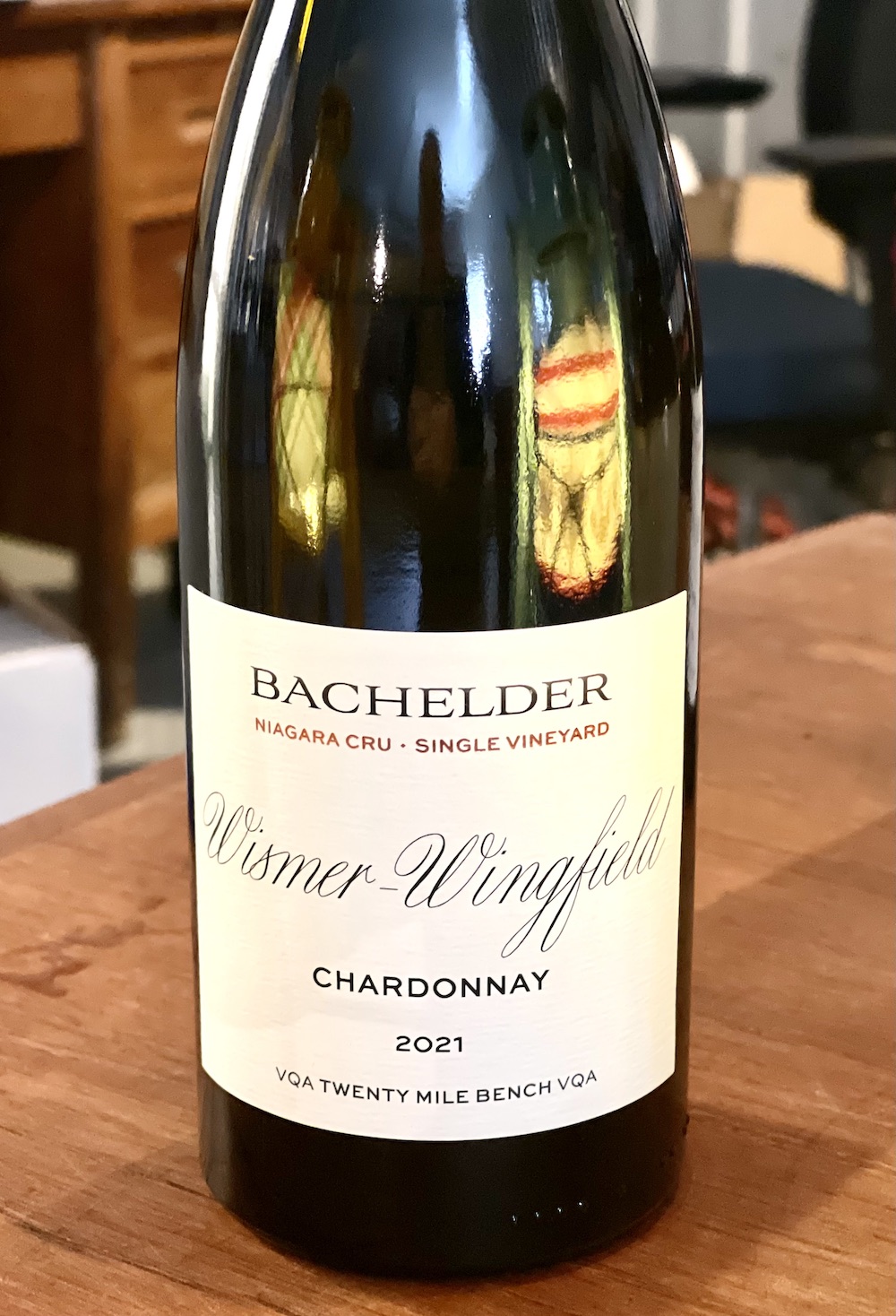
Bachelder Wines Wismer-Wingfield Vineyard Chardonnay 2021 ($60, 93 points) — This is another coveted site for Chardonnay in Bachelder’s arsenal of single-vineyard, single-block expressions. He keeps seven rows of the Wingfield Vineyard for the Hill of Wingfield, with some declassification into the Wismer-Wingfield expression. It has an enticing nose of stony minerality, white flowers, perfumed pear, lemon/citrus, nectarine, and fine oak spices. It has more concentration on the palate but tempered by an electric vein of acidity and showing ripe orchard fruits and lemon tart, a silky texture with a vibrant, lifted finish with a spicy bite.
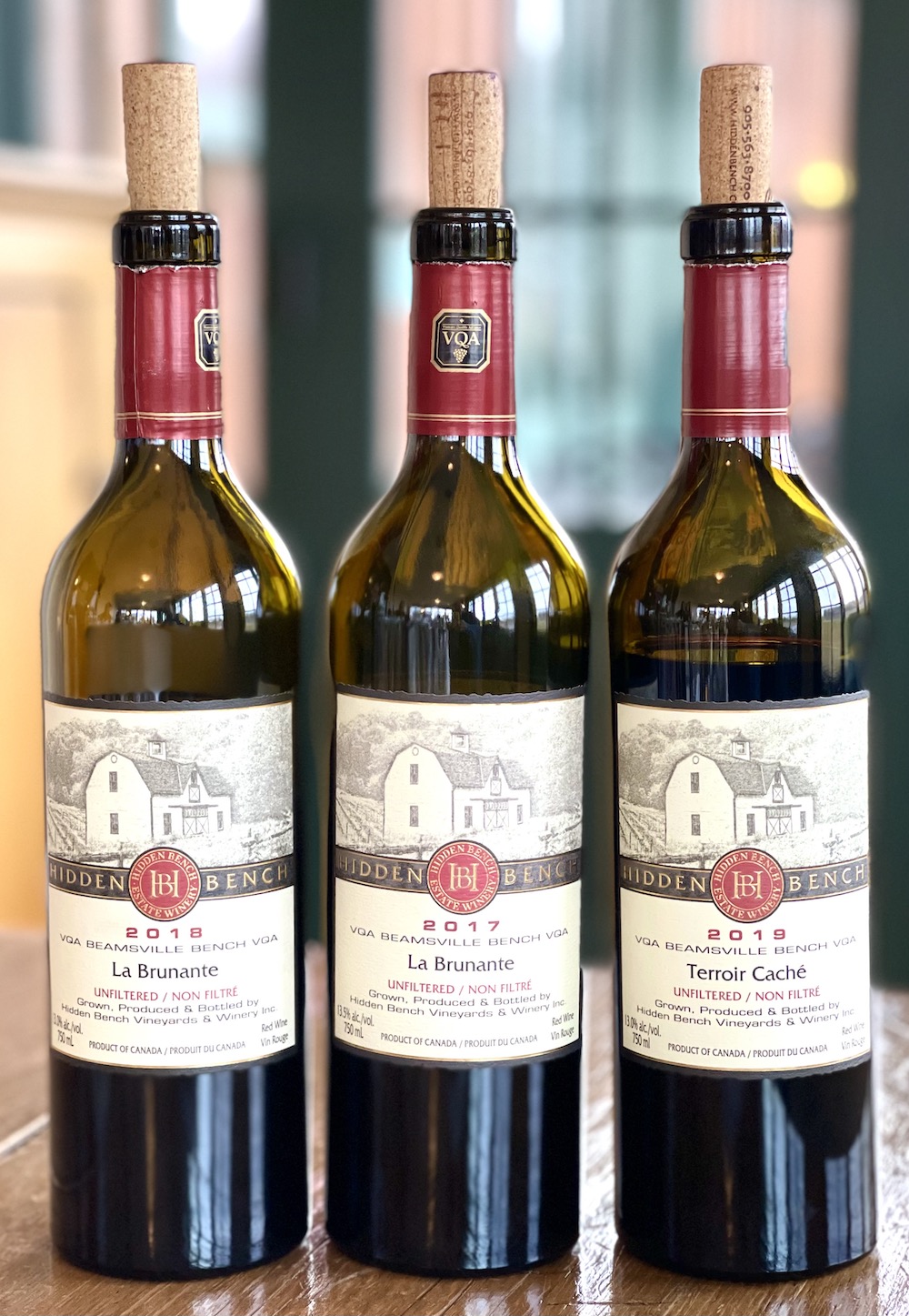
Hidden Bench La Brunante 2018 ($82, 95 points) — The 2018 version of this top Bordeaux-variety red blend is 62% Merlot, 24% Cabernet Franc and 14% Malbec with barrel aging in a combination of new and used French oak for 20 months and bottled unfiltered and unfined. Upon vigorous swirling in the glass, it reveals its full potential in layers of cassis, black currants, blackberries and densely fruited black raspberries, cherries, and plums with subtle earthy/savoury notes and more overt spice notes. It’s a bigger wine than the 2017 with a mouthful of dark berries, concentrated cherries and raspberries, lovely texture, ripe tannic structure, a touch of fresh turned soil, fine oak spice and rousing acidity keeping it all in check through the long, long, echoing finish.
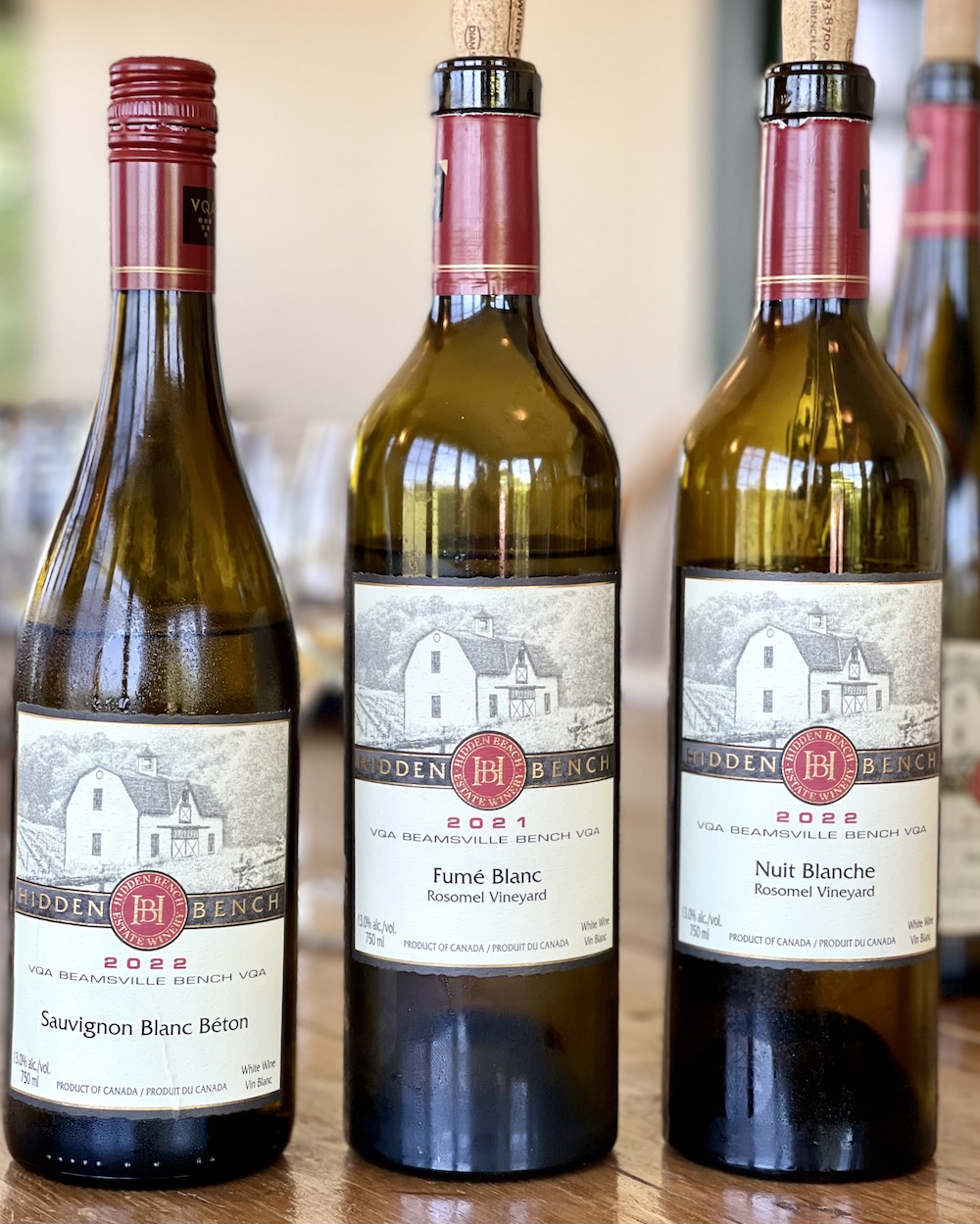
Hidden Bench Rosomel Vineyard Nuit Blanche 2022 ($40, 93 points) — The blend for the 2022 Nuit Blanche is 70% Sauvignon Blanc and 30% Semillon that’s aged in mostly older French oak barrels for 10 months. The nose is a bit tight on opening, but let it breathe and an elegant, nuanced Bordeaux-style white blend begins to emerge with a nose of Asian pear, nectarine, crunchy apple, kiwi, flinty minerality and integrated spices. It’s rich, flinty and persistent on the palate with grapefruit, passionfruit, herbs, fennel seed, and apple skin that benefits from a zesty, lively finish. Give it time to fully open up, either in the cellar or by decanting. Can cellar to 2028.
The post Dam, that was some hard grape picking, plus a primer for wine influencers to heed appeared first on Wines In Niagara.






